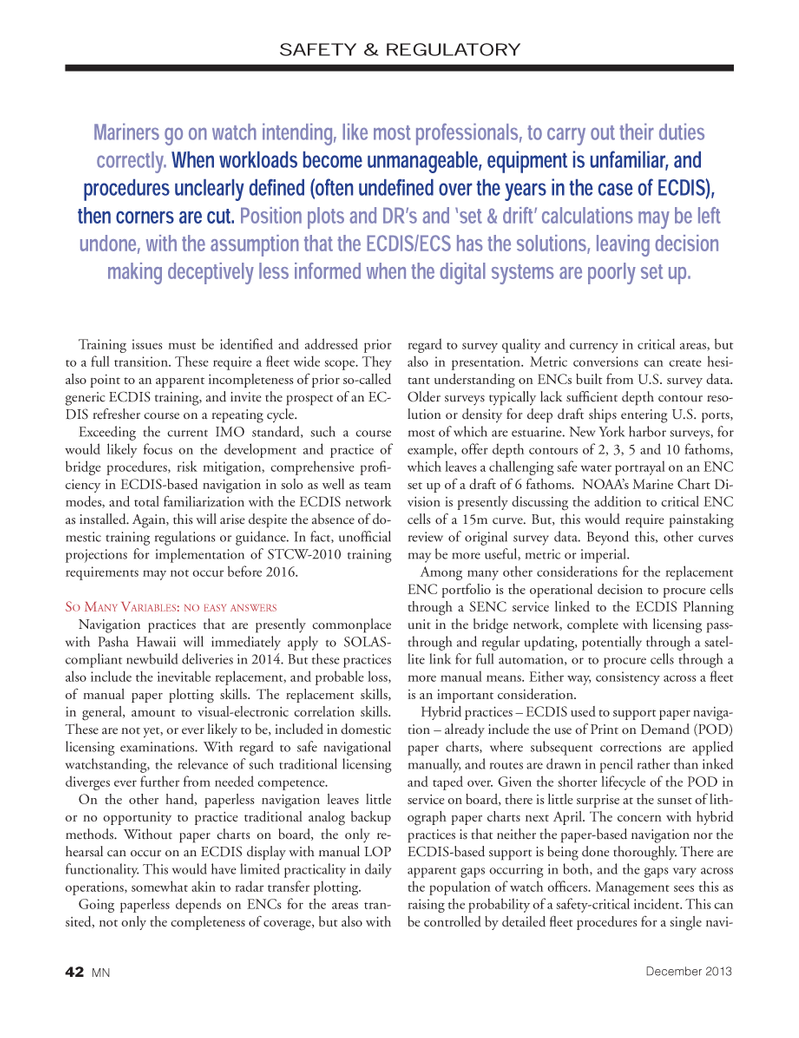
Page 42: of Marine News Magazine (December 2013)
Innovative Products & Boats of 2012
Read this page in Pdf, Flash or Html5 edition of December 2013 Marine News Magazine
Training issues must be identiÞ ed and addressed prior to a full transition. These require a ß eet wide scope. They also point to an apparent incompleteness of prior so-called generic ECDIS training, and invite the prospect of an EC- DIS refresher course on a repeating cycle. Exceeding the current IMO standard, such a course would likely focus on the development and practice of bridge procedures, risk mitigation, comprehensive proÞ -ciency in ECDIS-based navigation in solo as well as team modes, and total familiarization with the ECDIS network as installed. Again, this will arise despite the absence of do-mestic training regulations or guidance. In fact, unofÞ cial projections for implementation of STCW-2010 training requirements may not occur before 2016. SO MANY VARIABLES: NO EASY ANSWERSNavigation practices that are presently commonplace with Pasha Hawaii will immediately apply to SOLAS- compliant newbuild deliveries in 2014. But these practices also include the inevitable replacement, and probable loss, of manual paper plotting skills. The replacement skills, in general, amount to visual-electronic correlation skills. These are not yet, or ever likely to be, included in domestic licensing examinations. With regard to safe navigational watchstanding, the relevance of such traditional licensing diverges ever further from needed competence. On the other hand, paperless navigation leaves little or no opportunity to practice traditional analog backup methods. Without paper charts on board, the only re- hearsal can occur on an ECDIS display with manual LOP functionality. This would have limited practicality in daily operations, somewhat akin to radar transfer plotting. Going paperless depends on ENCs for the areas tran- sited, not only the completeness of coverage, but also with regard to survey quality and currency in critical areas, but also in presentation. Metric conversions can create hesi- tant understanding on ENCs built from U.S. survey data. Older surveys typically lack sufÞ cient depth contour reso- lution or density for deep draft ships entering U.S. ports, most of which are estuarine. New York harbor surveys, for example, offer depth contours of 2, 3, 5 and 10 fathoms, which leaves a challenging safe water portrayal on an ENC set up of a draft of 6 fathoms. NOAAÕs Marine Chart Di- vision is presently discussing the addition to critical ENC cells of a 15m curve. But, this would require painstaking review of original survey data. Beyond this, other curves may be more useful, metric or imperial. Among many other considerations for the replacement ENC portfolio is the operational decision to procure cells through a SENC service linked to the ECDIS Planning unit in the bridge network, complete with licensing pass- through and regular updating, potentially through a satel- lite link for full automation, or to procure cells through a more manual means. Either way, consistency across a ß eet is an important consideration. Hybrid practices Ð ECDIS used to support paper naviga- tion Ð already include the use of Print on Demand (POD) paper charts, where subsequent corrections are applied manually, and routes are drawn in pencil rather than inked and taped over. Given the shorter lifecycle of the POD in service on board, there is little surprise at the sunset of lith- ograph paper charts next April. The concern with hybrid practices is that neither the paper-based navigation nor the ECDIS-based support is being done thoroughly. There are apparent gaps occurring in both, and the gaps vary across the population of watch ofÞ cers. Management sees this as raising the probability of a safety-critical incident. This can be controlled by detailed ß eet procedures for a single navi- SAFETY & REGULATORY Mariners go on watch intending, like most professionals, to carry out their duties correctly. When workloads become unmanageable, equipment is unfamiliar, and procedures unclearly deÞ ned (often unde Þ ned over the years in the case of ECDIS), then corners are cut. Position plots and DR?s and ?set & drift? calculations may be left undone, with the assumption that the ECDIS/ECS has the solutions, leaving decision making deceptively less informed when the digital systems are poorly set up.42 MNDecember 2013MN Dec2013 Layout 32-49.indd 42MN Dec2013 Layout 32-49.indd 4211/25/2013 12:51:04 PM11/25/2013 12:51:04 PM

 41
41

 43
43
